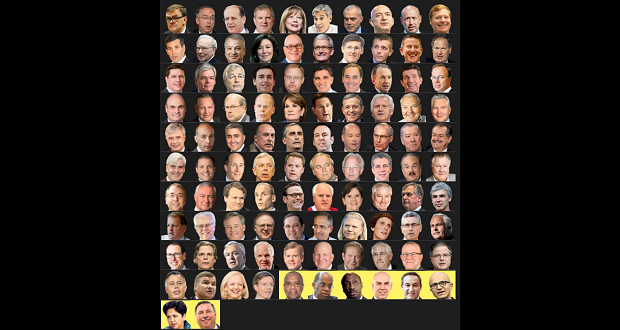
Screenshot from New York Times article: Leaders of the Largest American Companies
In case you missed it—A few weeks ago, The New York Times published, what I believe, to be a very telling feature story: “The Faces of American Power, Nearly as White as the Oscar Nominees”. I found it to be a very compelling visual, especially for when we talk about “systems” of power, and marginalization (and who governs those systems).
The writers of the story compiled a visual representation of individuals, whom they identified as being, some of the most powerful people in American culture, government, education, and business. They examined almost every aspect of American life—from who decides what movies and books are made, to who chooses what news gets covered, to who has a say in how our national and local politics are ran.
The areas they examined included:
- Leaders of the Largest American Companies
- The President and His Cabinet
- Presidents of Ivy League Universities
- S. Senators
- Hollywood Executives
- People who decide what Music gets produced
- Mayors of America’s Largest Cities
- People who Influence which Books Americans Read
- People who decide which TV shows Americans See
- People who decide what news gets covered
- US Supreme Court Judges
- American Governors
- Top Military Advisers
- Owners of Men’s Professional Basketball, Football, and Baseball Teams
In short, a lot of these areas or those that make up this “system” we so often refer to.
The list includes 503 leaders in total. To no surprise, of the 503 leaders, 44 are people of color. That’s about 8.7 percent. I find this piece interesting, relevant, and powerful for several reasons:
- In 2008 (and perhaps, still today), many were disillusioned by the false notion that having a Black man as President would be/has been the antidote to our nation’s structural inequities. In a sense, having a black man as President meant we had “arrived.” I think, today, more than ever, we know this not to be the case. While the President may hold the highest elected office in our country, it is very evident that the sole power to change its systems isn’t in his hands.
- The visual reminded me of a lecture I sat in last year, where Camara Jones used an allegory, “The Gardner’s Tale,” to deconstruct racism and its structural impact. She described a garden where red flowers weren’t blossoming at the rate of pink flowers, and some of the factors (including the actions taken by the gardener), that led to differences in how they bloomed. She used this analogy to convey the impacts of institutional racism. At the end of story, she posed the question, “Who is the gardener?” Who has the power to decide, the power to act, and is in control of resources? “The Faces of American Power” captures the answer to these questions, effectively.
- Lastly, in a day and age where our nation’s demographics continue to shift, becoming more multicultural, this image shows that many of our nation’s “rules” and many of the decisions about our future are still being established by people whose experiences may not reflect our current and future realities.
Perhaps, now more than ever, building culturally competent leaders is not only critical to our organizations, but our society-at-large. While I don’t anticipate the demographic make-up of “The Faces of American Power” changing overnight, I am hopeful that as more leaders and organizations continue to see the value of inclusion, we’ll see the manifestations in our society and systems, as well.


















